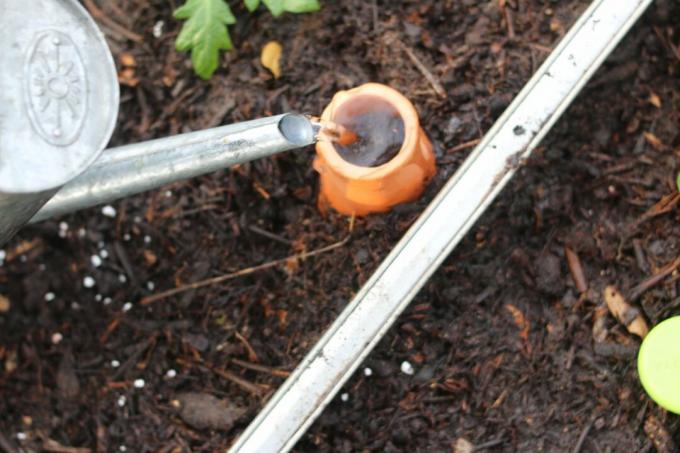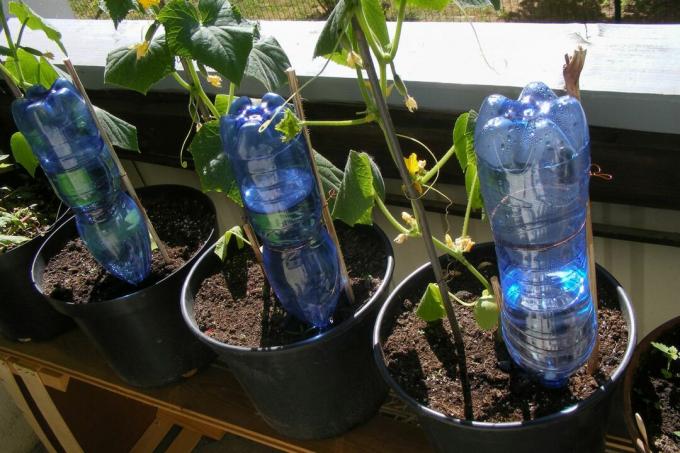With clay watering cones, you can go without watering the plants for a few days. Equipped with commercially available plastic bottles, the clay cones become water dispensers for your plants.

Due to its porosity, clay is an excellent starting material for irrigation aids. In this article you will learn how to use clay cones for watering plants, what advantages they offer, whether you can build clay cones yourself and much more.
contents
- How does watering with clay cones work?
- Water properly with clay cones
- Make clay cone irrigation yourself: instructions
How does watering with clay cones work?
Clay cones are a smart way to keep potted plants watered for longer periods of time, for example when you're on vacation. But how do the clay cones actually work? The clay cones, about the size of a finger, are placed on a standard plastic bottle filled with water instead of a lid. Then the clay cone is pressed into the ground with the water bottle. The water from the bottle runs into the clay cone and due to the porosity of the clay and the water pressure from above, the water slowly seeps into the ground. The way clay cones work is also related to soil water tension, also known as soil water tension. Soil suction is greater the drier it is - meaning the drier the substrate, the more "absorbent" it is. If the potting soil's moisture content is much greater than that of the clay, a lot of water will seep out of the clay cone. Thus, irrigation with clay cones is more needs-based than irrigation. However, this connection is only fully used by irrigation systems with drip hoses and water reservoirs, while Water bottles with a clay cone attachment press water into the ground through their sheer weight and are therefore a little less need-based water.

What Are the Benefits of Clay Cone Irrigation?
- Less watering: Depending on the thirst of the plants and the size of the bottle, the water reservoir in the bottle lasts until after your holiday.
- Needs-based water supply: As soon as the soil becomes too dry, new water seeps out of the clay cone. This ensures an even water supply.
- Save water: As the water leaves the irrigation cones underground, the surface of the earth remains drier. So less water evaporates.
- Prevention of fungus gnats: Another advantage of the drier soil surface: pests such as the annoying fungus gnats lay their eggs directly on the soil surface. If this is too dry when the larvae hatch, they die immediately, which is why fungus gnats avoid dry substrate. Read our special article for more tips on Fighting fungus gnats.
Tip: A watering method for your vegetable beds that works on the same principle are so-called ollas. The large, bulbous clay vessels are dug into the ground and then filled with water. Find out how in another article Irrigation with Ollas functions.

Water properly with clay cones
Using the clay watering cones is very easy. As described above, all you have to do is attach the clay cone to a plastic bottle with water.
You can buy clay cones for watering in a garden shop, in the garden department of a hardware store or on the Internet. Most clay cones are designed for use with standard plastic bottles. However, note the manufacturer's descriptions.
How long does the water reserve in the bottle last? That depends a lot on the needs of the plant, but also on the size of the bottle. A blanket statement cannot be made. When you go on vacation, it is best to test how long the water in the plastic bottle lasts beforehand. If necessary, you can then select a larger bottle.
Tip: Clay irrigation cones also come in a variety of sizes, with larger cones releasing more water than smaller ones.

Clay cones can also be used in beds or raised beds. Here, too, you should definitely test how many days your plants are supplied with water before you go on holiday. If necessary, add more clay cones.
tip: If you don't like the look of the plastic bottles in the pots or if you want to do without plastic, you can use glass bottles instead. Green wine bottles in particular are less conspicuous in the flower pots. When buying the clay cones, make sure that they are also designed for wine bottles.
At a glance: Using clay cones correctly
- Choose a suitable bottle: plastic or glass
- For plastic bottles: drill a hole in the bottom of the bottle to avoid negative pressure; Put the clay cone on the bottle opening and sink it into the ground; Fill the bottle with water over the hole
- For glass bottles: fill the bottle with water; Put the clay cone on the bottle opening and sink it into the ground
Clay cone and drip irrigation connected:
Some manufacturers also offer entire irrigation systems with clay cones. Several clay cones are connected to each other via a hose. The water reservoir is a large canister that supplies all the clay cones with water. Due to the suction tension, the system does not need a pump or an electronic control and can distribute more water both overall and selectively.

Make clay cone irrigation yourself: instructions
Clay cones for irrigation are not easy to make yourself. To do this, you must obtain clay, shape it appropriately, and then bring it to a pottery shop to fire the clay cone. In some places there are also pottery workshops that offer DIY days. It might be worth asking.

In our article on Plant watering on vacation Find more tips to keep your plants alive while you're away.
